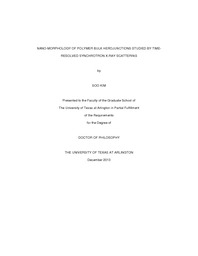
ATTENTION: The works hosted here are being migrated to a new repository that will consolidate resources, improve discoverability, and better show UTA's research impact on the global community. We will update authors as the migration progresses. Please see MavMatrix for more information.
Show simple item record
| dc.contributor.author | Kim, Soo | en_US |
| dc.date.accessioned | 2014-03-12T23:49:56Z | |
| dc.date.available | 2014-03-12T23:49:56Z | |
| dc.date.issued | 2014-03-12 | |
| dc.date.submitted | January 2013 | en_US |
| dc.identifier.other | DISS-12524 | en_US |
| dc.identifier.uri | http://hdl.handle.net/10106/24102 | |
| dc.description.abstract | This study investigates the phase transformation of an active layer in organic photovoltaics (OPV) during film deposition and post thermal treatment as well as effects of phase transformation on OPV performance. For this purpose, small - and wide angle X-ray scattering technique (SAXS and WAXS) was applied to examine the phase separation mechanism at relevant fabrication condition of the highest OPV device performance. The poly(3-alkylthiophene)/[6,6]-phenyl-C61 butyric acid methylester (P3AT/PCBM) blend sample was employed in order to study phase transformation of the active layer systemically.Our exploration with SAXS and WAXS technique found that the polarity of the substrate, a solubility, and solvent evaporation time determine the P3AT/PCBM morphology during the film deposition. On the basis of the results of the peak evolution with time at small and wide angle, the orientation of the P3AT crystal is highly affected by the polarity of the substrate while the type of solvents and their evaporation time can vary the degree of phase separation and P3AT crystallization.Spinodal decomposition was found to be mechanism for the phase separation of P3AT/PCBM blend driven by PCBM diffusion during post thermal treatment of P3AT/PCBM blend. This finding was obtained from the facts that kinetic of PCBM diffusion is faster than P3AT crystallization and alternating structure with long range order was evolved during the thermal annealing. An image extracted from Force Modulation Microscopy (FMM) further confirms phase separation mechanism of P3AT/PCBM. Finally, the morphology effects on OPV device performance were elaborated based on the long periodicity and invariant Q value. Since those values can stand for length of phase separation and amount of P3AT crystallization respectively, the importance of the phase separation and P3AT crystallization on the solar cell efficiency was explained. From the direct comparison of long periodicity and invariant Q to OPV device performance, it is found out that both nano-scale phase separation and P3AT crystallization process make contribution on the increment of the solar cell efficiency by enhancing exciton dissociation rate and hole mobility respectively. Moreover, further study using P3OT/PCBM blend showed that degree of phase separation plays a key role to determine OPV device performance more than P3AT crystallization. | en_US |
| dc.description.sponsorship | Kim, Choong-Un | en_US |
| dc.language.iso | en | en_US |
| dc.publisher | Materials Science & Engineering | en_US |
| dc.title | Nano-morphology Of Polymer Bulk Herojunctions Studied By Time-resolved Synchrotron X-ray Scattering | en_US |
| dc.type | Ph.D. | en_US |
| dc.contributor.committeeChair | Kim, Choong-Un | en_US |
| dc.degree.department | Materials Science & Engineering | en_US |
| dc.degree.discipline | Materials Science & Engineering | en_US |
| dc.degree.grantor | University of Texas at Arlington | en_US |
| dc.degree.level | doctoral | en_US |
| dc.degree.name | Ph.D. | en_US |
Files in this item
- Name:
- Kim_uta_2502D_12524.pdf
- Size:
- 2.337Mb
- Format:
- PDF
This item appears in the following Collection(s)
Show simple item record


